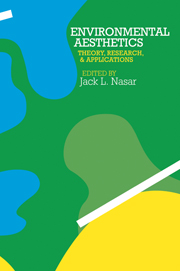Book contents
- Frontmatter
- Contents
- List of figures
- List of tables
- List of contributors and participants
- Acknowledgments
- Preface
- Section I Theory
- Section II Empirical studies
- Editor's introduction
- A Methodological comments
- B Architectural interiors
- C Architectural exteriors
- D Urban scenes
- Editor's introduction
- 18 Visual preferences in urban street scenes: a cross-cultural comparison between Japan and the United States
- 19 Perception and evaluation of residential street scenes
- 20 Planning concerns relating to urban nature settings: the role of size and other physical features
- 21 The effect of sign complexity and coherence on the perceived quality of retail scenes
- E Natural and rural scenes
- Section III Applications
- References
- Index of authors
- Subject index
19 - Perception and evaluation of residential street scenes
Published online by Cambridge University Press: 05 September 2013
- Frontmatter
- Contents
- List of figures
- List of tables
- List of contributors and participants
- Acknowledgments
- Preface
- Section I Theory
- Section II Empirical studies
- Editor's introduction
- A Methodological comments
- B Architectural interiors
- C Architectural exteriors
- D Urban scenes
- Editor's introduction
- 18 Visual preferences in urban street scenes: a cross-cultural comparison between Japan and the United States
- 19 Perception and evaluation of residential street scenes
- 20 Planning concerns relating to urban nature settings: the role of size and other physical features
- 21 The effect of sign complexity and coherence on the perceived quality of retail scenes
- E Natural and rural scenes
- Section III Applications
- References
- Index of authors
- Subject index
Summary
In recent years, public interest and policy (Carp, Zawadaski, and Shokrin, 1978; National Environmental Policy Act, 1969) have created a demand for objective information on perceived quality of the environment. Such information may be of particular importance for housing, because people typically spend more time in their homes than in any other place in the city (Chapin and Hightower, 1965) and because housing typically occupies more area than does any other land use in a city. Thus the home has been described as a primary territory that is ”central to the day-to-day lives of occupants … [and] psychologically important“ (Altman and Chemers, 1980, p. 129). Presumably, then, the visual quality of housing and the neighborhood is of some importance.
Nevertheless, some may question whether empirically based guidelines for visual quality are needed. For private housing, it might be argued that the market will produce a desirable outcome: People will select homes that they like. However, free choice at the individual level may result in visual disorder at the neighborhood level: Public regulations (such as zoning, design review, and building codes) are needed to control development. For public housing, the potential resident has little influence or choice with regard to the visual milieu of the housing, and the evidence (see Groat, 1982; Hershberger, 1969; Newman, 1972) suggests that the educated intuition of the design professional may not result in a milieu that fits the visual needs of the residents, especially if they differ in life style and social class from the professional.
- Type
- Chapter
- Information
- Environmental AestheticsTheory, Research, and Application, pp. 275 - 289Publisher: Cambridge University PressPrint publication year: 1988
- 23
- Cited by



